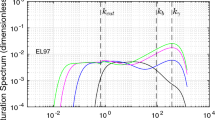Abstract
The issue of accounting of the wave breaking phenomenon in direct numerical simulations of oceanic waves is discussed. It is emphasized that this problem is crucial for the deterministic description of waves, and also for the dynamical calculation of extreme wave statistical characteristics, such as rogue wave height probability, asymmetry, etc. The conditions for accurate simulations of irregular steep waves within the High Order Spectral Method for the potential Euler equations are identified. Such non-dissipative simulations are considered as the reference when comparing with the simulations of occasionally breaking waves which use two kinds of wave breaking regularization. It is shown that the perturbations caused by the wave breaking attenuation may be noticeable within 20 min of the performed simulation of the wave evolution.














Similar content being viewed by others
References
Annenkov, S.Y., Shrira, V.I.: Spectral evolution of weakly nonlinear random waves: kinetic description versus direct numerical simulations. J. Fluid Mech. 844, 766–795 (2018)
Annenkov, S.Y., Shrira, V.I.: On the predictability of evolution of surface gravity and gravity–capillary waves. Phys. D 152, 665–675 (2001)
Bitner-Gregersen, E.M., Fernandez, L., Lefèvre, J.M., Monbaliu, J., Toffoli, A.: The North Sea Andrea storm and numerical simulations. Nat. Hazards Earth Syst. Sci. 14, 1407–1415 (2014)
Bitner-Gregersen, E.M., Toffoli, A.: Occurrence of rogue sea states and consequences for marine structures. Ocean Dyn. 64, 1457–1468 (2014)
Brennan, J., Dudley, J.M., Dias, F.: Extreme waves in crossing sea states. arXiv: 1802.03547v1 (2018)
Cavaleri, L.: Wave modeling: where to go in the future. Bull. Am. Meteor. Soc. 87, 207–214 (2006)
Chalikov, D.: Statistical properties of nonlinear one-dimensional wave fields. Nonlinear Proc. Geophys. 12, 671–689 (2005)
Chalikov, D.V.: Numerical Modeling of Sea Waves. Springer, New York (2016)
Dommermuth, D., Yue, D.K.P.: A High-Order Spectral Method for the study of nonlinear gravity waves. J. Fluid Mech. 184, 267–288 (1987)
Dommermuth, D.: The initialization of nonlinear waves using an adjustment scheme. Wave Motion 32, 307–317 (2000)
Ducrozet, G., Bonnefoy, F., Le Touze, D., Ferrant, P.: 3-D HOS simulations of extreme waves in open seas. Nat. Hazards Earth Syst. Sci. 7, 109–122 (2007)
Ducrozet, G., Bonnefoy, F., Le Touzé, D., Ferrant, P.: HOS-ocean: open-source solver for nonlinear waves in open ocean based on High-Order Spectral Method. Comput. Phys. Commun. 203, 245–254 (2016)
Ducrozet, G., Bonnefoy, F., Perignon, Y.: Applicability and limitations of highly non-linear potential flow solvers in the context of water waves. Ocean Eng. 142, 233–244 (2017)
Dyachenko, A.I., Kachulin, D.I., Zakharov, V.E.: Super compact equation for water waves. J. Fluid Mech. 828, 661–679 (2017)
Kharif, C., Pelinovsky, E., Slunyaev, A.: Rogue Waves in the Ocean. Springer, Berlin (2009)
Köllisch, N., Behrendt, J., Klein, M., Hoffman, N.: Nonlinear real time prediction of ocean surface waves. Ocean Eng. 157, 387–400 (2018)
Onorato, M., Osborne, A.R., Serio, M., Bertone, S.: Freak waves in random oceanic sea states. Phys. Rev. Lett. 86, 5831–5834 (2001)
Onorato, M., Osborne, A.R., Serio, M.: Extreme wave events in directional, random oceanic sea states. Phys. Fluids 14, L25–L28 (2002)
Ruban, V.P.: Quasiplanar steep water waves. Phys. Rev. E 71, 055303(R) (2005)
Seiffert, B.R., Ducrozet, G., Bonnefoy, F.: Simulation of breaking waves using the High-Order Spectral Method with laboratory experiments: wave-breaking onset. Ocean Model. 119, 94–104 (2017)
Slunyaev, A.V., Shrira, V.I.: On the highest non-breaking wave in a group: fully nonlinear water wave breathers vs weakly nonlinear theory. J. Fluid Mech. 735, 203–248 (2013)
Toffoli, A., Bitner-Gregersen, E.M.: Extreme and rogue waves in directional wave fields. The Open Ocean Eng. J. 4, 24–33 (2011)
Toffoli, A., Gramstad, O., Trulsen, K., Monbaliu, J., Bitner-Gregersen, E., Onorato, M.: Evolution of weakly nonlinear random directional waves: laboratory experiments and numerical simulations. J. Fluid Mech. 664, 313–336 (2010)
Toffoli, A., Onorato, M., Bitner-Gregersen, E., Osborne, A.R., Babanin, A.V.: Surface gravity waves from direct numerical simulations of the Euler equations: a comparison with second-order theory. Ocean Eng. 35, 367–379 (2008)
van Groesen, E., Turnip, P., Kurnia, R.: High waves in Draupner seas—Part 1: numerical simulations and characterization of the seas. J. Ocean Eng. Mar. Energy 3, 233–245 (2017)
van Groesen, E., Wijaya, A.P.: High waves in Draupner seas—Part 2: observation and prediction from synthetic radar images. J. Ocean Eng. Mar. Energy 3, 325–332 (2017)
West, B.J., Brueckner, K.A., Janda, R.S., Milder, D.M., Milton, R.L.: A new numerical method for surface hydrodynamics. J. Geophys. Res. 92, 11803–11824 (1987)
Xiao, W., Liu, Y., Wu, G., Yue, D.K.P.: Rogue wave occurrence and dynamics by direct simulations of nonlinear wave-field evolution. J. Fluid Mech. 720, 357–392 (2013)
Zakharov, V.: Stability of periodic waves of finite amplitude on a surface of deep fluid. J. Appl. Mech. Tech. Phys. 2, 190–194 (1968)
Zakharov, V.E., Dyachenko, A.I., Vasilyev, O.A.: New method for numerical simulation of a nonstationary potential flow of incompressible fluid with a free surface. Eur. J. Mech. B Fluids 21, 283–291 (2002)
Acknowledgements
The support from the Russian Foundation for Basic Research (Grants nos. 17-05-00067 and 18-05-80019) is acknowledged by AK. AS is grateful for the support from the Fundamental Research Programme of RAS “Nonlinear Dynamics”.
Author information
Authors and Affiliations
Corresponding authors
Additional information
Publisher's Note
Springer Nature remains neutral with regard to jurisdictional claims in published maps and institutional affiliations.
Rights and permissions
About this article
Cite this article
Slunyaev, A., Kokorina, A. Account of Occasional Wave Breaking in Numerical Simulations of Irregular Water Waves in the Focus of the Rogue Wave Problem. Water Waves 2, 243–262 (2020). https://doi.org/10.1007/s42286-019-00014-9
Received:
Accepted:
Published:
Issue Date:
DOI: https://doi.org/10.1007/s42286-019-00014-9




